Buena Park, California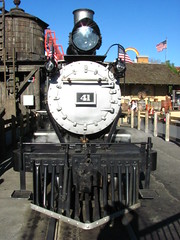
A stray black cat hunts for mice between the grave markers of old Boot Hill. The Butterfield Stagecoach rolls by as its occupants peer out the windows to watch a Native American dance. As the coach draws up in Ghost Town, a man with a felt hat secures his six-shooter in his holster before stepping into the Calico Saloon. Travelers stop to peruse dry goods and provisions. A nearby glassblower demonstrates his craft for a gathering of children, while the neighboring blacksmith hammers unperturbed. A shrill whistle cuts through the dry California air, emanating from the 41 Rio Grande Southern announcing its departure, which causes a nearby goose to momentarily give a glance before she goes back to preening her feathers. Once the train has passed and the gates have been raised, I cross the tracks and find a small lake is half filled with concrete, and a vibrant red and yellow $16,000,000 Swiss engineered steel roller coaster completely obliterates the few original remnants of the northwestern edge of Calico Ghost Town.
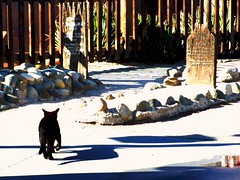 Has Cedar Fair been a positive or negative influence on Knott’s Berry Farm since their takeover in 1997? One look around the original southern California themer reveals a competently run business, friendly and homely, with good rides and a pleasing, western frontier inspired aesthetic… yet it often has a schizophrenic, fractured identity. There are high-quality themed environments, and high-quality thrill rides, and with few exceptions (none of them modern) these two identities do not come in contact with one another. As a park it certainly does not fit the mould of Cedar Fair’s traditional modus operandi, historically having much closer ties (at least as far as vision and audience) toDisneyland than Six Flags.
Has Cedar Fair been a positive or negative influence on Knott’s Berry Farm since their takeover in 1997? One look around the original southern California themer reveals a competently run business, friendly and homely, with good rides and a pleasing, western frontier inspired aesthetic… yet it often has a schizophrenic, fractured identity. There are high-quality themed environments, and high-quality thrill rides, and with few exceptions (none of them modern) these two identities do not come in contact with one another. As a park it certainly does not fit the mould of Cedar Fair’s traditional modus operandi, historically having much closer ties (at least as far as vision and audience) toDisneyland than Six Flags.
Knott’s is a popular, well-respected name in theme parks.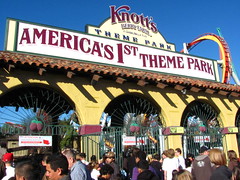 Their old west Calico Ghost Town is possibly the best known and loved tourist attraction of the ghost town genre, in a nation that is already madly in love with its romantic manifest destiny heritage. That’s quite an achievement for a family owned business to have built, and that’s not even including the technological achievements such as opening the world’s first modern looping roller coaster in 1975. For an institution in which the people so clearly loved what they did, it still seems a loss that it had to be sold to an entertainment chain whose sole competitive advantage was big, loud roller coasters.
Their old west Calico Ghost Town is possibly the best known and loved tourist attraction of the ghost town genre, in a nation that is already madly in love with its romantic manifest destiny heritage. That’s quite an achievement for a family owned business to have built, and that’s not even including the technological achievements such as opening the world’s first modern looping roller coaster in 1975. For an institution in which the people so clearly loved what they did, it still seems a loss that it had to be sold to an entertainment chain whose sole competitive advantage was big, loud roller coasters.
But there was even a time not too long ago when Cedar Fair was the white hatted good guy of the amusement park industry, partly because they didn’t obsess over brand like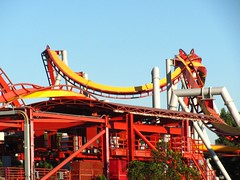 every other chain worldwide and allowed each of their parks to maintain and develop their own unique, locally specialized identity. Somewhere around the time when they were sniffing out old Six Flags and Paramount properties, that philosophy from HQ changed and the company experienced a subtle shift from “no brand” to “The Generic Brand”. Or maybe it was always like that and it took a decade before enough had been altered to genuinely change the perception of the park. I do think it sad that the Knott’s family agreed to a buyout from Cedar Fair over a competing offer from Disney on the belief that the former would let their established formula work rather than immediately bring in a new philosophy, but so far history has suggested that the opposite has been the case.
every other chain worldwide and allowed each of their parks to maintain and develop their own unique, locally specialized identity. Somewhere around the time when they were sniffing out old Six Flags and Paramount properties, that philosophy from HQ changed and the company experienced a subtle shift from “no brand” to “The Generic Brand”. Or maybe it was always like that and it took a decade before enough had been altered to genuinely change the perception of the park. I do think it sad that the Knott’s family agreed to a buyout from Cedar Fair over a competing offer from Disney on the belief that the former would let their established formula work rather than immediately bring in a new philosophy, but so far history has suggested that the opposite has been the case.
There’s a lot of Cedar Fair influence that would be easy to rag upon (including a semi-questionable ticket practice I found at the main gate.1) Yet as easy as it might be, I’m going to hold off on that for a moment and note that Knott’s did need the corporate muscle to get to where they are today. As much as SoCal theme park lovers might feel nostalgic about Knott’s glory days, you gotta admit that by the time Windjammer showed up the place had long since jumped the shark, and I still can’t imagine a better improvement get Knott’s back in the game than Cedar Fair did with the announcement of the Supreme Scream / Ghostrider combo immediately after taking over. Things were pretty bright under Cedar Fair for the next five years, all the way up to the way cool Xcelerator replacing the dopey Windjammer in 2002 (coincidentally the year of my first and, until today, only visit to Knott’s). And you know what: I like the new roller coasters. I won’t lie and say I split my time evenly between the old Knott’s and the new Knott’s; the coasters are the main reason I was there and that was reflected in the fact that I was willing to devote twenty minutes for the Intamin launch coaster (twice) but not for the steam train.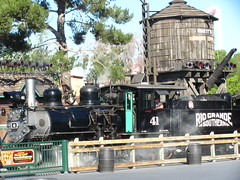
Yet I can’t help but feel that Cedar Fair lost a big opportunity to learn from Knott’s successes and apply them to the rest of their chain, instead borrowing only their Peanuts license and Halloween event and letting the rest of Knott’s creative talents continue to go about their jobs at home for a couple years until I presume they all retired, at which point Kinzel exported the rest of his managers and directors straight from Sandusky to show Knott’s how it’s done. There were moments when I was walking through Knott’s original ghost town that my breath was taken away, not because I was that particularly amazed by it (I’m still the guy that’s skeptical about themed aesthetics, by the way) but because it was so radically different from anything I had ever seen in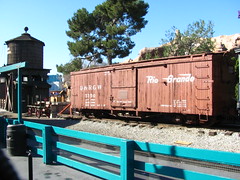 any other Cedar Fair park. A number of buildings and pathways are there just to explore, with a large section of Ghost Town basically having zero mechanical functionality, its purpose being nothing more complex than to enhance the view. They’ve even retained their Stagecoach attraction which continues to use actual, living horses as the sole source of power! I thought Cedar Fair “didn’t do” animals, especially not animals that a major attraction depends on? Of course, these sections of the park also had some of the lowest crowd density, so maybe the Sandusky offices know what they’re doing when they’ve not installed a single immersive themed attraction in the Knott’s tradition since ’97.
any other Cedar Fair park. A number of buildings and pathways are there just to explore, with a large section of Ghost Town basically having zero mechanical functionality, its purpose being nothing more complex than to enhance the view. They’ve even retained their Stagecoach attraction which continues to use actual, living horses as the sole source of power! I thought Cedar Fair “didn’t do” animals, especially not animals that a major attraction depends on? Of course, these sections of the park also had some of the lowest crowd density, so maybe the Sandusky offices know what they’re doing when they’ve not installed a single immersive themed attraction in the Knott’s tradition since ’97.
On the whole Knott’s Berry Farm remains an excellent park, quite easily the most visually appealing and varied property in Cedar Fair’s chain, one that incoming CEO Matt Ouimet was right to call the hidden “jewel” of the company (and hopefully he was referring to more than the fact that Knott’s annual attendance outranks the flagship Cedar Point). But the theme park half of its identity ranks second behind Disneyland, and the thrill ride half of its identity ranks second to Magic Mountain, and with each of these identities occupying their own separate hemispheres such that nothing unique is offered by the atomic collision of the theme park and roller coaster worlds, Knott’s ultimately ranks third overall. It’s a good place to go if you need a one-day sampler plate of everything in the L.A. theme park base, but positioning themselves in the middle of the market can be a dangerous game if not played right.
quite easily the most visually appealing and varied property in Cedar Fair’s chain, one that incoming CEO Matt Ouimet was right to call the hidden “jewel” of the company (and hopefully he was referring to more than the fact that Knott’s annual attendance outranks the flagship Cedar Point). But the theme park half of its identity ranks second behind Disneyland, and the thrill ride half of its identity ranks second to Magic Mountain, and with each of these identities occupying their own separate hemispheres such that nothing unique is offered by the atomic collision of the theme park and roller coaster worlds, Knott’s ultimately ranks third overall. It’s a good place to go if you need a one-day sampler plate of everything in the L.A. theme park base, but positioning themselves in the middle of the market can be a dangerous game if not played right.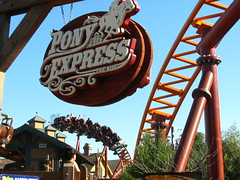
The 2008-built Pony Express is symptomatic of Knott’s duality. Located at the end of the Ghost Town trail in an area previously far removed from the nearest thrill ride (making it an important magnet to circulate the shifted thrill-seeking clientele through all corners of the park), the Pony Express shows an attempt to integrate itself with the local atmosphere, but either through budgetary limits or (my opinion) managerial ineptitude, falls short of that goal. Alright, so the name and look of the vehicles fit the role, there’s a bit of a storyline based on real history to give it a motive, and the old-west styled station could have been much worse (could have been much better, too). It’s still an undisguised steel roller coaster awkwardly shoehorned into a place that was never intended for a steel roller coaster of any make. Oh, and it’s also bright red and yellow, to not break the tradition of painting all of Knott’s new coasters red and/or yellow. God damn, after a full day at Knott’s I really grew to loath the sight of red and yellow roller coasters. (Actually it also could have been worse. The other color combo Knott’s seems to have taken a liking to in recent years is purple and lime green.)
for a steel roller coaster of any make. Oh, and it’s also bright red and yellow, to not break the tradition of painting all of Knott’s new coasters red and/or yellow. God damn, after a full day at Knott’s I really grew to loath the sight of red and yellow roller coasters. (Actually it also could have been worse. The other color combo Knott’s seems to have taken a liking to in recent years is purple and lime green.)
 This is the first ride I head to in the morning, under the true belief that if I waited till the crowds filled into the back I would be looking at a very slow-moving queue line. In a move of brilliance Knott’s
This is the first ride I head to in the morning, under the true belief that if I waited till the crowds filled into the back I would be looking at a very slow-moving queue line. In a move of brilliance Knott’s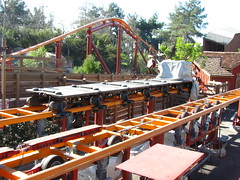 selected Zamperla to provide a third launched coaster for the park with a capacity of 16 riders per train, with only one train running the rails for nearly the entire 2011 season. That was the result of an even greater move of brilliance when the two trains collided last autumn due to Knott’s painting over the anti-rollback fin brakes. As the second person in line for the day I take a seat in the back row, when the attendant informs me that I’ll have to remove my glasses and put them
selected Zamperla to provide a third launched coaster for the park with a capacity of 16 riders per train, with only one train running the rails for nearly the entire 2011 season. That was the result of an even greater move of brilliance when the two trains collided last autumn due to Knott’s painting over the anti-rollback fin brakes. As the second person in line for the day I take a seat in the back row, when the attendant informs me that I’ll have to remove my glasses and put them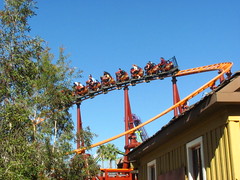 in a cubby. They’re not secured, but neither were they on X2 the previous night and I still had them this morning. I look at him for a moment, and then look at the 44’ tall, 36mph roller coaster ahead of us. He can’t be serious. He was.
in a cubby. They’re not secured, but neither were they on X2 the previous night and I still had them this morning. I look at him for a moment, and then look at the 44’ tall, 36mph roller coaster ahead of us. He can’t be serious. He was.
Look, Knott’s, between the two of us, I’m not the one that goes around painting my brake fins red. I appreciate the liberty you take to look out for your guest’s safety when they might not know better, but unless there’s a clear and immediate danger present it’s generally better to have a simple warning and leave it to the individual’s discretion. It gives people the impression that they still have free-will and autonomous responsibility, which if they’re going to be pulling cash out of their wallets anytime during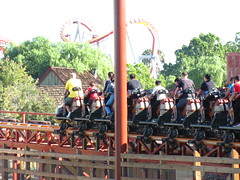 their visit is something you want them to think they have. Of course once I ascertained that it was a command and not a suggestion I complied without further protest; something I should get used to as it is a common rule but enforced completely arbitrarily (nothing like this rule anywhere else in Southern California, and even among Cedar Fair parks, rides as big as Millennium Force are a-okay with me wearing glasses in whatever manner I see fit, and I’ve never once lost any corrective lenses in all my years of riding).
their visit is something you want them to think they have. Of course once I ascertained that it was a command and not a suggestion I complied without further protest; something I should get used to as it is a common rule but enforced completely arbitrarily (nothing like this rule anywhere else in Southern California, and even among Cedar Fair parks, rides as big as Millennium Force are a-okay with me wearing glasses in whatever manner I see fit, and I’ve never once lost any corrective lenses in all my years of riding).
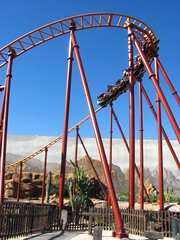 The Express ended up being a blur to me, but not because of the high speed. We roll forward onto the launch track paralleling
The Express ended up being a blur to me, but not because of the high speed. We roll forward onto the launch track paralleling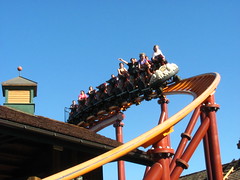 the trail, coming to a stop as the cable drive catch engages with the train. The launch would be quite mundane if it weren’t for the slightly unusual seating arrangements in a tipped forward ‘horse riding’ position that feels as if there’s not enough holding you in from behind when the train rushes forward. At the end of the launch we rush up into the elevated far turnaround (wait… we’re already at the far turnaround?),
the trail, coming to a stop as the cable drive catch engages with the train. The launch would be quite mundane if it weren’t for the slightly unusual seating arrangements in a tipped forward ‘horse riding’ position that feels as if there’s not enough holding you in from behind when the train rushes forward. At the end of the launch we rush up into the elevated far turnaround (wait… we’re already at the far turnaround?), where we slow down for a bit of a fan turn dug carefully into the graves of once peaceful Boot Hill. Turning back the way we came, there’s a gentle (read: forceless) hill over the railroad tracks and launch, curving back around the station. If there’s one good thing about this weak beginning it’s that the layout will have a relatively strong finish by comparison. There’s a tighter s-curve hill next to the Big Foot Rapids, where a semi-interesting back-and-forth trick-track is achieved before going into the tunneled turnaround. This tunnel looks ridiculous and makes no thematic sense, but it’s a nice touch when on ride nevertheless. The layout needs whatever help it can get. Then there’s one last half of a hill, the opposing downward slope is all magnetic brakes.
where we slow down for a bit of a fan turn dug carefully into the graves of once peaceful Boot Hill. Turning back the way we came, there’s a gentle (read: forceless) hill over the railroad tracks and launch, curving back around the station. If there’s one good thing about this weak beginning it’s that the layout will have a relatively strong finish by comparison. There’s a tighter s-curve hill next to the Big Foot Rapids, where a semi-interesting back-and-forth trick-track is achieved before going into the tunneled turnaround. This tunnel looks ridiculous and makes no thematic sense, but it’s a nice touch when on ride nevertheless. The layout needs whatever help it can get. Then there’s one last half of a hill, the opposing downward slope is all magnetic brakes.
 That’s it. A simple out and back run (which is really just a ‘back’ run since the station, launch and brakes take up the entire ‘out’ side) with a total of four drops along the layout. Five if you want to count the brake run. I rode it four times in a row and on none of those rides could I figure out a point to its existence. It certainly did not come into being when someone at Knott’s said, “I’ve got a really great idea for a roller coaster!” It looks more like someone from the upper management wanted to drive attendance for 2008 and so put in an order for a roller coaster after finding a deal at Zamperla’s IAAPA desk, leaving it as an April Fool’s prank for their planning and development team to find some way, any way to fit it in the park lest their contract go to waste. (“No, I didn’t know where we were going to put it, but the Italian salesman said it was BOGO Tuesday… how could anyone pass a deal like that up?”)
That’s it. A simple out and back run (which is really just a ‘back’ run since the station, launch and brakes take up the entire ‘out’ side) with a total of four drops along the layout. Five if you want to count the brake run. I rode it four times in a row and on none of those rides could I figure out a point to its existence. It certainly did not come into being when someone at Knott’s said, “I’ve got a really great idea for a roller coaster!” It looks more like someone from the upper management wanted to drive attendance for 2008 and so put in an order for a roller coaster after finding a deal at Zamperla’s IAAPA desk, leaving it as an April Fool’s prank for their planning and development team to find some way, any way to fit it in the park lest their contract go to waste. (“No, I didn’t know where we were going to put it, but the Italian salesman said it was BOGO Tuesday… how could anyone pass a deal like that up?”)
The biggest problem is that the Pony Express theme should be evocative of a journey of some sort, but since the action of the ride basically traces the easiest and most visually obvious route back the way we only just came, that psychological dimension of having a coaster that “takes us someplace”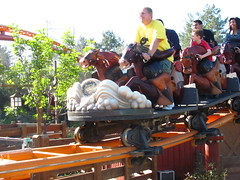 is completely missing. Yeah, the park is woefully short of spare room, but I wish an attempt had been made to loop the layout either around/over the big blue structure to the left or over/under Ghost Town and Big Foot Rapids to the right… or at least to remove the Screamin’ Swing upcharge ride so that the out-and-back layout could have been stretched just a little bit longer, maybe with six hills instead of four. I also would have kept the layout much closer to the ground and had the track interact with scenic set pieces like the classic Knott’s themed rides, so the coaster at least somewhat compliments rather than contradicts the semi-authentic Ghost Town landscape. But no, Cedar Fair had to take the simplest, cheapest, least imaginative route, because their business structure is set up with absolutely no dedicated creative offices,
is completely missing. Yeah, the park is woefully short of spare room, but I wish an attempt had been made to loop the layout either around/over the big blue structure to the left or over/under Ghost Town and Big Foot Rapids to the right… or at least to remove the Screamin’ Swing upcharge ride so that the out-and-back layout could have been stretched just a little bit longer, maybe with six hills instead of four. I also would have kept the layout much closer to the ground and had the track interact with scenic set pieces like the classic Knott’s themed rides, so the coaster at least somewhat compliments rather than contradicts the semi-authentic Ghost Town landscape. But no, Cedar Fair had to take the simplest, cheapest, least imaginative route, because their business structure is set up with absolutely no dedicated creative offices,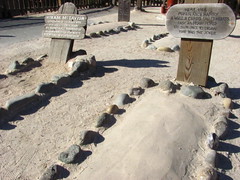 unlike every other Theme Park of its size and reputation on the planet. When the only questions being asked are questions of financing and predicted returns, a ride like Pony Express was bound to result.
unlike every other Theme Park of its size and reputation on the planet. When the only questions being asked are questions of financing and predicted returns, a ride like Pony Express was bound to result.
Compare it to a ride like the Calico Mine Ride. Now there’s an attraction, cornball as it may be, that was clearly built from a love of the creative pursuit. Its creator was theme park pioneer Bud Hurlbut, who invested every penny he had to make the ride a reality for visitors in 1960, among them a highly impressed Walt Disney. Given the ride’s legacy it’s hard not to be as impressed as old man Walt, as this attraction set the agenda for almost every dark ride that came after it, while still being a unique piece of equipment unlike any I’ve seen elsewhere. Hidden from view in the rocky crags of a multi-story, cartoonish papier-mâché mountain, riders such as yours truly had no idea what to expect when we piled into an open air, restraintless mine train and the conductor threw the brakes, lurching the train forward into the cavern entrance. The technology is completely non-standard for similar amusement devices; our vehicles are powered by gravity with the conductor’s only duty (besides narrating the scenery and cracking jokes) is to apply the brakes to keep the train at a constant, gentle clip.
in the rocky crags of a multi-story, cartoonish papier-mâché mountain, riders such as yours truly had no idea what to expect when we piled into an open air, restraintless mine train and the conductor threw the brakes, lurching the train forward into the cavern entrance. The technology is completely non-standard for similar amusement devices; our vehicles are powered by gravity with the conductor’s only duty (besides narrating the scenery and cracking jokes) is to apply the brakes to keep the train at a constant, gentle clip.
We roll slowly past scenes of limestone formations and turn-of-the-century mining operations, eventually encountering a roller coaster lift hill complete with anti-rollback clank-clank-clank. I’m conditioned by the sound all too well to expect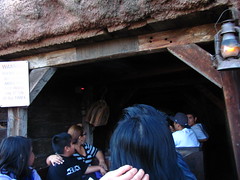 an exciting development at the top, so it was a bit of a disappointment to be faced with a similarly stolid excursion past a colorfully cavernous room. It’s still the highlight of the ride just for the scenery alone, the neon stalagmites and tites undoubtedly the inspiration for more than one child of the 60’s Calico Mine Trip, the set design extending several floors both above and below the pathway the train takes. We eventually roll out the mine, through a humorous “cut-out” rock formation, and back into a final tunnel that promises an explosive finish. Like the rest of the mine there’s not much action even when the whole thing is blowing up; some show lights and sound effects are the full extent of the dynamite blast. We pick up a little bit of extra speed, but it never quite cooks, and then we’re back to the unload platform, nearly seven minutes after our departure.
an exciting development at the top, so it was a bit of a disappointment to be faced with a similarly stolid excursion past a colorfully cavernous room. It’s still the highlight of the ride just for the scenery alone, the neon stalagmites and tites undoubtedly the inspiration for more than one child of the 60’s Calico Mine Trip, the set design extending several floors both above and below the pathway the train takes. We eventually roll out the mine, through a humorous “cut-out” rock formation, and back into a final tunnel that promises an explosive finish. Like the rest of the mine there’s not much action even when the whole thing is blowing up; some show lights and sound effects are the full extent of the dynamite blast. We pick up a little bit of extra speed, but it never quite cooks, and then we’re back to the unload platform, nearly seven minutes after our departure.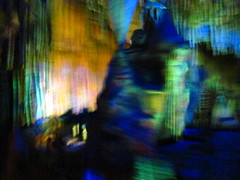
The fact that it’s not a roller coaster when it almost could have been doesn’t bother me at all. If I have one criticism to offer, it’s that I think Hurlbut would have achieved better results if more focus was put on telling a story through the ride rather than just looking at the scenery (imagine: “Mystery of the Calico Mine Ride”… okay, maybe that would kind of suck, but you get the idea).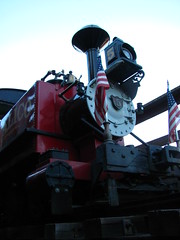 The nature tour guide narration isn’t very involving for the younger generations as it’s clear we’re looking at an artificial construct from yesteryear, and the jokey, ironic inserts describing the action have become a theme park cliché. But it was still a quirky pleasure, especially for theme park aficionados, if not only because it was a delight to perceive the Calico Mine Ride as the loving handmade effort of a small group of dedicated individuals making the best with the resources they had available, and blazing new pathways for successors as a result. The ride is very much chained to its history, but since when did that ever stop real enjoyment from being had? If anything the fact that it’s gleefully outdated and out of synch with the 21st century makes it all the more hallowed and reverential, a rare commodity in today’s theme parks. Should Ouimet ever gets the idea to ‘upgrade’ the interior of the ride after more than fifty years, it would be nothing short of sacrilege.
The nature tour guide narration isn’t very involving for the younger generations as it’s clear we’re looking at an artificial construct from yesteryear, and the jokey, ironic inserts describing the action have become a theme park cliché. But it was still a quirky pleasure, especially for theme park aficionados, if not only because it was a delight to perceive the Calico Mine Ride as the loving handmade effort of a small group of dedicated individuals making the best with the resources they had available, and blazing new pathways for successors as a result. The ride is very much chained to its history, but since when did that ever stop real enjoyment from being had? If anything the fact that it’s gleefully outdated and out of synch with the 21st century makes it all the more hallowed and reverential, a rare commodity in today’s theme parks. Should Ouimet ever gets the idea to ‘upgrade’ the interior of the ride after more than fifty years, it would be nothing short of sacrilege.
Hurlbut’s other iconic ride at Knott’s, the Timber Mountain Log Ride, was not operating today. This was a real shame, as it was the one ‘classic’ Knott’s ride that I had been most looking forward to (I also missed it back in 2002), and I have read nothing but raves that sound as though it would quiet my weak criticisms of the Calico Mine Ride. Oh well, watch this space in the future when I get a chance to return to Knott’s to review it and a few of the other legacy Ghost Town attractions I missed out on today.
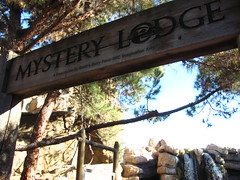 The Mystery Lodge I knew almost nothing about, but the very name of it invited… hmm… mystery? I of course had to catch a performance that day to find out what was going on. The first clue to the mystery I discovered was this: don’t arrive too early because they force everyone to stand in a compacted waiting room for at least ten minutes after the show is scheduled to start. I was certainly not the only person that found being taken out of the direct sunlight after a full day of walking and riding caused my legs to turn to jelly, and ahhh why do they have to keep filling in the room, these losers are late, can’t they just open the doors and let us sit down already!? A drumbeat, announcement, and pre-show introduction to the Native American historical/educational theme finally announce the opening of the floodgates to the main showroom,
The Mystery Lodge I knew almost nothing about, but the very name of it invited… hmm… mystery? I of course had to catch a performance that day to find out what was going on. The first clue to the mystery I discovered was this: don’t arrive too early because they force everyone to stand in a compacted waiting room for at least ten minutes after the show is scheduled to start. I was certainly not the only person that found being taken out of the direct sunlight after a full day of walking and riding caused my legs to turn to jelly, and ahhh why do they have to keep filling in the room, these losers are late, can’t they just open the doors and let us sit down already!? A drumbeat, announcement, and pre-show introduction to the Native American historical/educational theme finally announce the opening of the floodgates to the main showroom,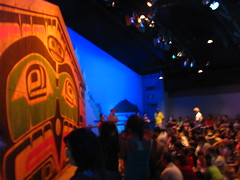 and we can all take our seats.
and we can all take our seats.
And now the Mystery behind the Lodge (Danger! Here be spoilers!) – there’s really only one ‘trick’, but it’s a good one that I have never seen before and still can’t quite figure out all the practical nuances of how it works. Between the stage and the seating is a large pane of glass that allows them to project, Haunted Mansion style, three-dimensional holograms into the stage area. The stage itself is pretty minimalist in props and design, with a single actor on stage and a fire pit, although the distinction between the physical and optical is quite clear. Here they do some really cool, imaginative effects that don’t just involve projections but tricks to the physical props as well. The best is when the actor disappears – 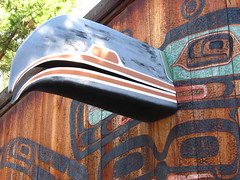 not through the obfuscation of a puff of smoke, but just slowly fades away before our eyes, leaving only a mask (physical, not optical!) floating in his place, and the cane he had been holding (again, physical, not optical!) remains standing upright until the mask floats off, and then topples over.2
not through the obfuscation of a puff of smoke, but just slowly fades away before our eyes, leaving only a mask (physical, not optical!) floating in his place, and the cane he had been holding (again, physical, not optical!) remains standing upright until the mask floats off, and then topples over.2
In the wake of cultural entities like Pixar it has become almost axiomatic to ask in response, “the story should always come first, so how does this technology serve the story?” Well, the technology is such a huge facet of the Mystery Lodge experience that it would be naïve to assume the story was the first thing discussed in the attraction’s development… but it was clear they had some good writers on the project who wanted to put the technology to proper service. An elderly Native American storyteller describes his life after an encounter with what he believes to be the owl spirit of death. He recalls his time growing up as a boy when he was enchanted by wondrous stories told around the campfire, and what these stories taught him as he went through life, fell in love, had children, grandchildren… all the way to today when he is now facing the prospect of death alone. (I won’t give away the ‘tricky’ ending.)
Framing the action as all part of campfire storytelling was the most prescient narrative device the writers offered, as the magical effects don’t have to be supposed literally for it to still have truth-value in the form of what the magic represents in metaphor. This is directly referenced near the end when the storyteller walks back on stage after a vanishing act and suggests what we saw was all smoke and magic, but that the authenticity was found the personal act of dreaming itself. I have a fond appreciation for meta-narratives, and was glad to see it take place in a theme park attraction, which I think right now is the best solution to overcoming the inherent artificiality of the experience.
However, I can’t let the theme park die-hards delude themselves into believing that the story is anything deeper than kitsch. What I mean by ‘kitsch’ is that the viewer already knows how to feel (or how they’re supposed to feel) as soon as they encounter each moment. So when the storyteller says that the part of us that shares stories and laughter with the ones we love will never die, he’s not actually challenging the audience to deeply consider this claim, it’s already familiar and prepackaged with a sense of warm fuzzy truthfulness (the sumptuous, overbaked music is to remove all doubts). The themes of communion with nature, the old ways of the ancestors, and the liberal humanist values were all-too familiar to me, having gone through elementary school in rural northern Michigan not far from Ottawa and Chippewa reserves and under a school administrative board suffering from white guilt complexes and PBS documentary fetishes.
(the sumptuous, overbaked music is to remove all doubts). The themes of communion with nature, the old ways of the ancestors, and the liberal humanist values were all-too familiar to me, having gone through elementary school in rural northern Michigan not far from Ottawa and Chippewa reserves and under a school administrative board suffering from white guilt complexes and PBS documentary fetishes.
But at least the story’s more original than most theme park kitsch (no franchised characters for the win!), and if that term ‘kitsch’ has too negative a connotation, remember that pretty much everything on Broadway is no different. Heck, all of pop-culture is kitsch but that doesn’t mean pop-art isn’t possible, it just requires that we recognize where it comes from and how to interpret it. Theme parks are close but not quite at the level of achieving authentic pop-art, and are even further from that elusive apple of genuine art. Mystery Lodge is a step in the right direction, and it’s disappointing to see that Cedar Fair has no apparent interest in furthering this evolution.
Which brings this review back to its original topic: what good has Cedar Fair done for Knott’s?
In a word: GhostRider. That’s where Cedar Fair did good.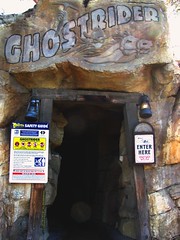
The goodness starts as soon as I enter the queue, through a dark, creepy mine shaft with the ride’s logo engraved in the stone at the entrance. Definitely one of the coolest entrances for a wooden coaster I’ve ever found. The next segment of queue winds over an arid landscape where I keep an eye out for black widows or scorpions along the trail in between watching the elegant, serpent-like pre-lift track that runs next to the trail. A silver seven car PTC squealing around the bend is music to my ears. Although built by Custom Coasters Intl., the masters of getting results on a slim budget, GhostRider has the magnificent presence of the old-school breed of monster wooden roller coasters, with its overbuilt, golden brown support structure able to withstand anything the San Andreas fault line can dish out at it, and the ominous 118’ tall lift hill extending away from us so whatever awaits on the other end is kept secret. The rest of the queue is contained in a massive, three story station mining house full of old western details (and mercifully plenty of fans).
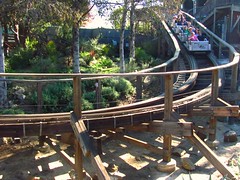 The dedication to a high quality visual appearance is what makes me think Knott’s held on to a lot of their creative staff and ways of doing things for the first several seasons after Cedar Fair’s takeover, as this 1998-built ride seems to exhibit the perfect combination of old school Walter Knott and Bud Hurlbut showmanship with high impact Dick Kinzel style thrills (the PTC trains even have the unusual extra detailing of airbrushed ghost paintings on the sides of each of the cars). CCI brings plenty to the table as well, providing a wooden coaster aesthetic that is very classical with its double out-and-back layout highlighting both swooping and flat elevated curves, and the flowing parabolic hills. If one didn’t know better they might almost guess GhostRider belonged on Walter Knott’s farm since the very beginning.
The dedication to a high quality visual appearance is what makes me think Knott’s held on to a lot of their creative staff and ways of doing things for the first several seasons after Cedar Fair’s takeover, as this 1998-built ride seems to exhibit the perfect combination of old school Walter Knott and Bud Hurlbut showmanship with high impact Dick Kinzel style thrills (the PTC trains even have the unusual extra detailing of airbrushed ghost paintings on the sides of each of the cars). CCI brings plenty to the table as well, providing a wooden coaster aesthetic that is very classical with its double out-and-back layout highlighting both swooping and flat elevated curves, and the flowing parabolic hills. If one didn’t know better they might almost guess GhostRider belonged on Walter Knott’s farm since the very beginning.
Given the all-clear, our carriage rumbles around the first ground-hugging s-bend between shrubs and cacti as a clever introduction to this Ghost with the Most. We then ascend the lift hill, where at the top a tin shed covers the length of the first drop to help muffle the noise that many riders will be making at this point. While the view is hindered, it makes the freefall a perversely claustrophobic sensation, and hanging over the edge in the front row there’s an enhanced vanishing point effect. Down the 51° drop we go, shredding through a cavern of southern yellow pine at the bottom while howling through an intense lateral jam at 56 mph. Breathless only moments into the action, the ghost gives us a breath of air with a long camelback hill. The following swoop turn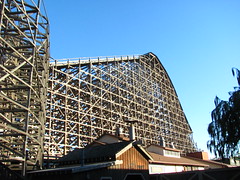 over California Plaza and subsequent dogleg run back towards the station house exhibit a very traditional pacing and dynamic in kinship with the west coast boardwalk woodies; not exactly ultra intense or unpredictable, but a joyous celebration of the wooden coaster form. This series terminates with a slow, flat elevated turn above the station, providing an overview of Ghost Town and a midcourse respite.
over California Plaza and subsequent dogleg run back towards the station house exhibit a very traditional pacing and dynamic in kinship with the west coast boardwalk woodies; not exactly ultra intense or unpredictable, but a joyous celebration of the wooden coaster form. This series terminates with a slow, flat elevated turn above the station, providing an overview of Ghost Town and a midcourse respite.
After the brake run, one encounters a maneuver known simply as “The Drop”. This name results from a combination of very tight radius curve over the edge, extra-long seven car trains, and coming off a flat stretch rather than a pointed crest so the rear of the train doesn’t act as a counterweight. Those in the back rows especially are given a hostile welcoming to the second half of the layout, a progression that emulates the first half in form, but is re-characterized from a high-speed, airy identity to that of a fiery, superstructure shredding one. Smaller airtime hills hit at a faster timing interval with as much force as the first, and the mosaic of interlacing wood patterns engulfing the far turnaround can nearly be trance-inducing if watched too closely. We get two more solid airtime hills before the ride wraps up with a grand finale, a downhill double helix that starts flat and full of sustained laterals, and evolves a carouseling undulation on the lower level just to make certain we get the point (and to force us to hold on if we’ve been arms up so far). It’s one of those excellent punctuation marks for a wooden coaster layout, second in CCI’s oeuvre only to Shivering Timbers.
of the layout, a progression that emulates the first half in form, but is re-characterized from a high-speed, airy identity to that of a fiery, superstructure shredding one. Smaller airtime hills hit at a faster timing interval with as much force as the first, and the mosaic of interlacing wood patterns engulfing the far turnaround can nearly be trance-inducing if watched too closely. We get two more solid airtime hills before the ride wraps up with a grand finale, a downhill double helix that starts flat and full of sustained laterals, and evolves a carouseling undulation on the lower level just to make certain we get the point (and to force us to hold on if we’ve been arms up so far). It’s one of those excellent punctuation marks for a wooden coaster layout, second in CCI’s oeuvre only to Shivering Timbers.
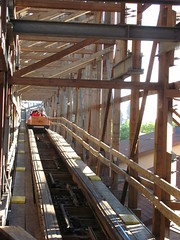 The combination of visual thematic presentation and integration with the existing park, the classical aesthetic mixed with modern, intense dynamics, and a long, progressive ride narrative with a strong beginning, middle and end, makes me wish to declare GhostRider as still the Best in the West, even after a pair of Six Flags GCI beauties have given it worthy competition (no comment on the Giant Dippers, there are some comparisons that can simply not be made in good taste). While not at the pinnacle of their output, the ride remains on my short list for the best of Custom Coasters. For those in need of a comparison, I could describe GhostRider as a more organized
The combination of visual thematic presentation and integration with the existing park, the classical aesthetic mixed with modern, intense dynamics, and a long, progressive ride narrative with a strong beginning, middle and end, makes me wish to declare GhostRider as still the Best in the West, even after a pair of Six Flags GCI beauties have given it worthy competition (no comment on the Giant Dippers, there are some comparisons that can simply not be made in good taste). While not at the pinnacle of their output, the ride remains on my short list for the best of Custom Coasters. For those in need of a comparison, I could describe GhostRider as a more organized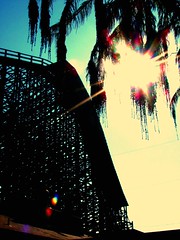 Legend, or a longer Cornball Express, or a Megafobia with a greater variation in pacing. This is the one coaster that in my mind CCI got the least wrong, although the lack of a singular brilliant stroke of inspiration means it doesn’t quite reach the same heights as Timbers, Raven or Boulder Dash.
Legend, or a longer Cornball Express, or a Megafobia with a greater variation in pacing. This is the one coaster that in my mind CCI got the least wrong, although the lack of a singular brilliant stroke of inspiration means it doesn’t quite reach the same heights as Timbers, Raven or Boulder Dash.
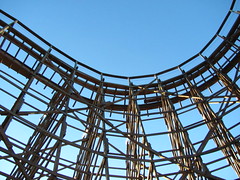 This all said, to write this review I needed to reach further back into my 2002 experiences with the Ghost to do the ride as much justice as I’ve just now done. Here’s one last talking point to throw in the pile of ways Cedar Fair has not been the greatest for Knott’s: it’s gotten damn rough. 2011 was a particularly bad season, as to cope with the roughness Knott’s turned the midcourse brake run all the way on to bring the train to a complete halt before continuing the second half of the layout, removing much of the venom from The Drop.
This all said, to write this review I needed to reach further back into my 2002 experiences with the Ghost to do the ride as much justice as I’ve just now done. Here’s one last talking point to throw in the pile of ways Cedar Fair has not been the greatest for Knott’s: it’s gotten damn rough. 2011 was a particularly bad season, as to cope with the roughness Knott’s turned the midcourse brake run all the way on to bring the train to a complete halt before continuing the second half of the layout, removing much of the venom from The Drop.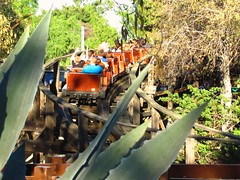 Surprisingly, the subsequent hills and helices continue to pace quite well, with some light negative G’s still present, which only makes me long for the days when it blasted through this second half at full speed. Part of the problem might be contributable to the rolling stock, as the very front row had no problems with jack hammering or shuffling. So that’s two seats out of twenty eight that GhostRider is still a champion in… better than none, I suppose, provided you’re willing to wait the extra time. Back-to-back front seat rides at the end of the night, with the grease at its slickest and the wind at its crispest, reaffirmed my faith in the quality of GhostRider as a top tier ride, quite easily my favorite wooden coaster experience I’d have in 2011 (and the competition would include Fireball and T-Express).
Surprisingly, the subsequent hills and helices continue to pace quite well, with some light negative G’s still present, which only makes me long for the days when it blasted through this second half at full speed. Part of the problem might be contributable to the rolling stock, as the very front row had no problems with jack hammering or shuffling. So that’s two seats out of twenty eight that GhostRider is still a champion in… better than none, I suppose, provided you’re willing to wait the extra time. Back-to-back front seat rides at the end of the night, with the grease at its slickest and the wind at its crispest, reaffirmed my faith in the quality of GhostRider as a top tier ride, quite easily my favorite wooden coaster experience I’d have in 2011 (and the competition would include Fireball and T-Express).
But a fair warning to Knott’s Berry Farm: if the situation on GhostRider doesn’t improve by my third visit to your park, whenever that might be… words will be said. Oh yeah. Be scared. Like you’ve just seen a ghost.
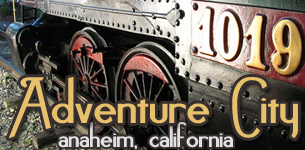
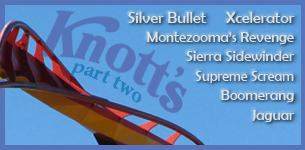
Footnotes and Annotations
[1] The morning was 70°F, the skies were clear and sunny, and I approached Knott’s Berry Farm’s ticket windows bundled up in a Michigan State sweater. No, I did not develop a thyroid problem overnight, Knott’s had been running a college bowl promotion for the month of January where anyone wearing their university colors could get a $20 discount off the standard ticket price. Even though I figured the savings were subtracted from the ‘normal’ online listed price of $56.99 rather than the print-at-home $46.99, that was still a $10 net savings that I was not going to pass up, despite not actually having the Spartan colors with me. Rummaging through my aunt’s closet before leaving that morning we discovered an old sweatshirt she forgot she had, and here I was. Only problem was when I got to the front gate I found out Knott’s was playing by a bit of the ol’ bait-and-switch; the actual gate ticket prices were about $6 higher than those listed on the website, meaning my net savings for having to carry around a wholly unnecessary sweater the whole day was only $4, which had I known beforehand I wouldn’t have bothered. I later went back over Knott’s website and could find no mention of the $62.99 price, despite that being the ticket from which all their online deals and discounts are subtracted from, nor could I figure out who would pay the phantom price of $56.99 that actually was listed on the website. I’m actually kicking myself for not getting a picture of the sign when I was at the gate, because I cannot find any third-party information online to corroborate my story (every other website I found agrees the at-the-gate price should be around $57, not in the low $60’s). It’s almost to the point that I want to convince myself I dreamed the whole scenario, if I didn’t so vividly remember seeing a price tag with a six in the first decimal place and being patently annoyed with then handing over part of the money I had allotted for lunch.
[2] Of technical interest, I’d like if Knott’s could go back to the engineers and see if they can upgrade the glass screen that makes the optical effects possible. There are some black reinforcement bars running through it that I’d like removed, especially because from my vantage point parts of the stage were partly obscured by the bars. It also reflects a little too much light off the audience, which meant at many times my eyes were focusing on the glass rather than what was happening behind the glass. ‘Magic’ only works if we sense having a spatiotemporal immediacy with it, requiring that we always be looking through the glass rather than at the glass. Otherwise the experience is little different from the cinema, removed from the tangible reality by a protective fourth wall. That is a primary advantage of the stage over the screen, but that advantage is somewhat lacking from Mystery Lodge.
The entrance to Ghostrider that you enjoyed so much is actually comprised of the last remnants of the Pan for Gold attraction that the park had leveled years ago. For a fee, participants could pan for “gold” with the assistance of a weathered miner and keep whatever ended up in their pan in a take-home vial, a truly memorable earned souvinir. It was certainly one of the signature non-ride experiences in the park for the majority of the visitors until its relocation to another, less thematically impressive section of the park.
Just out of curiosity, why is it that in your Essentials, there is no mention of GhostRider? You said that it was your favorite wooden coaster of 2011 (over T-Express and Fireball), yet both of those are in your top 25 wooden coasters.